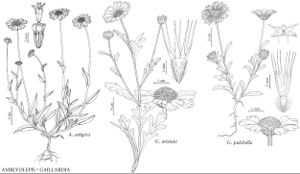Gaillardia
Observ. Phys. 29: 55. 1786 (as Gaillarda).
Hist. Acad. Roy. Sci. Mém. Math. Phys. (Paris, 4to) 1786: 5. 1788.
| Taxon | Illustrator ⠉ | |
|---|---|---|
 | Amblyolepis setigera Gaillardia aristata Gaillardia pulchella | Yevonn Wilson-Ramsey Barbara Alongi Barbara Alongi |
Annuals, perennials, or subshrubs, 10–80+ cm (sometimes rhizomatous). Stems usually erect, usually branched (from bases or throughout). Leaves basal, basal and cauline, or mostly cauline; alternate; petiolate or sessile; blades mostly elliptic, lanceolate, linear, oblong, obovate, ovate, or spatulate, often pinnately lobed, ultimate margins toothed or entire, faces usually scabrellous to villous (hairs simple or jointed), rarely glabrous, usually notably glanddotted (except in 10. G. suavis). Heads usually radiate or discoid (sometimes radiant), borne singly. Involucres hemispheric to nearly rotate, mostly 9–20+ mm diam. Phyllaries persistent, 14–40+ in 2–3+ series (reflexed in fruit, usually distinct, oblanceolate, lanceolate, narrowly triangular, or linear, subequal to unequal, usually chartaceous proximally, distally herbaceous, apices often attenuate). Receptacles convex to hemispheric, smooth or pitted (often with scattered, hard, setiform enations), epaleate. Ray-florets 0, or 5–15+, usually neuter, rarely pistillate and fertile or styliferous and sterile; corollas yellow to white or orange to red, purplish, or brown, often bicolored (sometimes “ray” corollas funnelform, 5-lobed, heads radiant). Disc-florets 20–100+, bisexual, fertile; corollas yellow or orange to red, purplish, or brown (distally ± shaggily hairy, hairs jointed), tubes much shorter than ampliate, campanulate to cylindric or urceolate throats, lobes 5, broadly deltate or ovate (± equal, sometimes attenuate or attenuate-terete apically; style-branch apices ± attenuate, usually hispidulous). Cypselae obpyramidal to clavate, ± 4-angled (lengths 1–1.5+ diams.), sparsely to densely hairy (at least proximally, hairs straight); pappi usually persistent, of 6–10+ medially thickened, laterally scarious scales in 1–2 series (all, some, or none aristate), rarely 0. x = 19.
Distribution
North America, Mexico, South America (mostly Argentina)
Discussion
Species 15–17 or more (11 in the flora).
Some horticultural gaillardias may be derived from hybrids (e.g., Gaillardia ×grandiflora van Houtte) involving G. aristata and some other species (probably G. pulchella). Such horticultural plants sometimes persist after cultivation or occur sporadically as waifs in places well beyond the “natural” ranges of the “parent” species; e.g., scattered localities in Arizona and California.
Selected References
Lower Taxa
Key
| 1 | Leaves all basal (sometimes extending onto proximal 1/3+ of stems in desert annual G. arizonica), blades glabrous or sparsely villous (hairs jointed) | > 2 |
| 1 | Leaves basal and cauline or all cauline (restricted to proximal 1/3 or less of plants in some perennials; mostly cauline in annuals), blades hispidulous to scabrellous or strigillose to villous (hairs simple or jointed) | > 3 |
| 2 | Ray florets 0 or 7–10, corollas red to purple; disc corollas pinkish or purplish; pappus scales aristate, 6–9 mm | Gaillardia suavis |
| 2 | Ray florets 10–13, corollas yellow to orange; disc corollas yellow; pappus scales muticous or aristate, 2–5 mm | Gaillardia arizonica |
| 3 | Receptacles rarely setose (setae 0.1–1 mm); lobes of disc corollas attenuate-terete(bearing jointed hairs to 0.3 mm) | Gaillardia aestivalis |
| 3 | Receptacles usually setose (setae 0.3–6 mm); lobes of disc corollas ovate to deltate, sometimes attenuate (usually bearing jointed hairs 0.3+ mm, hairs shorter in G. coahuilensis) | > 4 |
| 4 | Annuals or perennials (seldom from woody caudices); cypselae hairy (hairs inserted at bases and sometimes on angles, not on faces) | > 5 |
| 4 | Perennials (often with woody caudices, seldom flowering first year); cypselae hairy (hairs inserted at bases and on angles and faces) | > 8 |
| 5 | Perennials (sometimes flowering first year); leaves basal and cauline; receptacular setae (2–)3–6+ mm | Gaillardia aristata |
| 5 | Annuals (seldom persisting); leaves all or mostly cauline; receptacular setae mostly 0.3–3 mm | > 6 |
| 6 | Hairs on disc corollas to 0.3 mm | Gaillardia coahuilensis |
| 6 | Hairs on disc corollas 0.3+ mm | > 7 |
| 7 | Ray corollas usually bicolored (brown-purple to red proximally, tipped with yellow or orange), rarely unicolored; lobes of disc corollas deltate to ovate, often attenuate, 1–3+ mm; cypselae all alike | Gaillardia pulchella |
| 7 | Ray corollas usually uniformly dark red to purple, rarely yellow; lobes of disc corollas mostly ovate-deltate to lanceolate, 0.5–1 mm; cypselae dimorphic (outer longer than inner and with shorter pappus scales) | Gaillardia amblyodon |
| 8 | Leaves (most or all) usually pinnatifid, rarely entire; disc corollas usually purplish or purple-tipped, rarely wholly yellow | Gaillardia pinnatifida |
| 8 | Leaves (most or all) entire or toothed; disc corollas yellow or purplish | > 9 |
| 9 | Leaf blades linear, 3–5(–8+) mm wide, faces sparsely hispidulous or glabrate; disc corollas usually purplish | Gaillardia multiceps |
| 9 | Leaf blades mostly oblanceolate to spatulate, usually (at least the larger) 10–25 mm wide, faces closely puberulent or sericeous to villous; disc corollas yellow | > 10 |
| 10 | Leaves mostly basal, sometimes some to mid stems; peduncles 10–30 cm; cypselae mostly 1–2 mm | Gaillardia parryi |
| 10 | Leaves mostly cauline; peduncles 2–6(–10) cm; cypselae mostly 3–4 mm | Gaillardia spathulata |